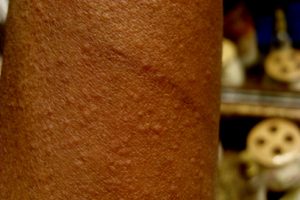Allergies are a part of virtually every human being’s life. It’s very common to hear someone say they had to take an antihistamine due to excess pollen in the air, or that they experienced skin problems because of a certain medication, among many other stories that happen from time to time. But there is a specific allergy that many people don’t believe really exists: heat allergy. But can it really affect us? What are its characteristics? How do you treat this type of allergy? In today’s text, we will answer these and many other questions. Check it out now!
What is Heat Allergy?
What we popularly call heat allergy or allergy to heat is what, in medical terms, is known as cholinergic urticaria. Contrary to what many might imagine, this reaction isn’t caused by hot temperatures per se, but by the effects that heat can have on our bodies. Sweat itself can be the cause, especially when combined with certain fabrics or jewelry, and can end up causing allergic reactions on our bodies that we wouldn’t normally have on days with more pleasant temperatures. Cholinergic urticaria is characterized by small red bumps that may appear in various parts of our bodies, especially on the back and neck area. These bumps can also show up on the torso, arms, and legs, though that’s less common. Although it is more common in young adults, this type of allergy can occur in people of any age. 
Why Do We Have Heat Allergy?
As we have already said, the allergic reactions our bodies have do not come directly from heat, but from the effects it can cause in us. This happens because, when our body temperature rises too much, we release sweat that, in turn, contains acetylcholine. What happens, in people who have heat allergy, is an allergy to acetylcholine. Therefore, some of the factors that can trigger this type of allergy are:
- Very hot days
- Physical activity
- Very hot baths
- Very spicy foods
Studies indicate that factors such as excessive stress and anxiety can also trigger bouts of cholinergic urticaria. However, as these factors are not directly related to an increase in our body temperature, we won’t go into detail on this matter.
Symptoms of Heat Allergy
The main symptoms that heat allergy can present are:
- Itching of the skin, especially on the back and neck area
- Swelling of the skin
- Burning sensation on the skin
- Small red bumps that cause itching
In more severe cases, other symptoms may appear, such as:
- Difficulty breathing
- Nausea and vomiting
- Diarrhea
It’s worth noting that these last symptoms are usually more rare and show up in people who are even more sensitive and who usually aren’t undergoing any kind of allergy treatment.
Is Miliaria Also a Heat Allergy?
Even though we are speaking specifically about cholinergic urticaria, there is another type of allergy that arises because of heat, called miliaria. Also known as heat rash, it causes inflammation of the skin, preventing sweat from exiting. This causes small blisters to form, resulting in irritation and itching of the skin. Depending on how deep these go in our skin, cases of miliaria can be more or less severe. This type of allergy most commonly appears in babies, but it can affect people of any age. The treatment of both types of allergy that we’ve mentioned today are quite similar, so it’s possible to discuss both at the same time.
How to Treat Heat Allergy?
Treatment for both heat rash and miliaria consists of using medicines that reduce symptoms and ease itching and even the burning sensation on the skin. These types of allergies have no cure, but there are ways to prevent them from arising. One of the main ways is making sure your body stays cool most of the time, especially during summer. Another thing that often helps is, as soon as you start to sweat, taking a shower to avoid further contact of your body with acetylcholine. Of course, it’s not always possible to take this kind of measure, but whenever you can, do so to avoid allergic reactions.
When to See a Doctor?
As with many other types of allergy, the recommendation is to seek a doctor when you notice that your symptoms are disrupting your life in some way. Although heat allergy doesn’t cause any severe harm to your health, it can be quite bothersome and prevent you from having peaceful moments in the heat. Therefore, seek medical care so the treatment can be started and so this doesn’t stop you from living a comfortable life and enjoying what you like to do. Heat allergy isn’t uncommon, though many people are unaware of it. Still, as you may have noticed, it’s not hard to treat, although it does require special care to avoid more serious complications if someone is affected. As with any other type of allergy, treatment should begin at the first symptoms to keep it from getting worse. That way, we avoid headaches that certainly won’t do us any good.











